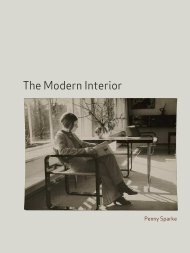Landscape Architecture: Landscape Architecture: - School of ...
Landscape Architecture: Landscape Architecture: - School of ...
Landscape Architecture: Landscape Architecture: - School of ...
- No tags were found...
Create successful ePaper yourself
Turn your PDF publications into a flip-book with our unique Google optimized e-Paper software.
The recent work <strong>of</strong> Beigel and Christou has developed through<br />
the research they carried out for an experimental project for a<br />
site in eastern Germany, at Cospuden, close to Leipzig. The<br />
purpose <strong>of</strong> the Second Nature <strong>Landscape</strong> project was to lay out<br />
a carpet <strong>of</strong> specifically landscape terrain, as a kind <strong>of</strong> generator<br />
<strong>of</strong> form, so providing the basis for an emergent architectural<br />
landscape – laying out the rug, but not the picnic.<br />
Research was carried out into the evident natural and<br />
occupational memory traces <strong>of</strong>fered by the landscape,<br />
ranging from its geological origins, through prehistoric times<br />
and primitive 17th-century flood preventive schemes and the<br />
l8th-century manor house and estate that developed, to the<br />
despoliation <strong>of</strong> all this as a result <strong>of</strong> large-scale coal-mining<br />
operations. Now the rug contains an overlay <strong>of</strong> incipient<br />
ecological measures. The deep scars <strong>of</strong> the open-cast mining<br />
are being flooded, which over the next 30 years will permit<br />
the formation <strong>of</strong> a postindustrial city on a recreational lake –<br />
a city <strong>of</strong> dreams.<br />
In a purely landscape reclamation context one is reminded<br />
<strong>of</strong> Ge<strong>of</strong>frey Jellicoe’s 50-year-long project for the Hope Cement<br />
Works in Derbyshire, England, in the Peak District there. But<br />
ambitions at Leipzig embrace a whole city scheme. The<br />
extreme horizontality <strong>of</strong> the new landscape opens many<br />
possibilities, which Beigel and Christou have envisioned and<br />
to which the Leipzig authorities have given their support.<br />
The site stretches over a 50-kilometre (31-mile) radius south<br />
<strong>of</strong> Leipzig and will eventually be transformed into a postindustrial,<br />
recreational, city lake landscape. The Cospuden<br />
project has become a prototype design for the meanings <strong>of</strong><br />
the new lakes and for the different ways the city is<br />
approaching its new lake shores – the revalidation <strong>of</strong> so-called<br />
‘emptied sites’ in the words <strong>of</strong> ARU.<br />
A long, straight lake includes promenades and the<br />
retention <strong>of</strong> the straight edges <strong>of</strong> the coal-dust protection<br />
forests planted at right angles to the dams. The plan<br />
designated the s<strong>of</strong>t lake shore as a wilderness and the straight<br />
shore as the new urban terrain, having a hard edge.<br />
This is, as a whole, an ecological terrain which has now<br />
become an urban wetland, but it is crossed with care by a<br />
timber jetty. The wetland acts as a catchment field, part <strong>of</strong> a<br />
surface-water management strategy in which the relatively<br />
unclean surface water flowing down the sloping suburban<br />
territories towards the new lake is retained separately from<br />
the clear groundwater <strong>of</strong> the lake itself.<br />
The project as a whole could be described as a landscapescale<br />
architectural infrastructure that will provide a spatial<br />
framework for buildings in the future.<br />
<strong>Architecture</strong> Research Unit, Second Nature <strong>Landscape</strong>, Cospuden, Leipzig,<br />
Germany, ongoing<br />
Urban design plan from June 1998 showing, left to right: the public wetland<br />
next to the lake; new ‘lake villas’ and ‘longhouses’ in blue-grey on a new<br />
territory forming a straight edge to the wetland; and the new village repair<br />
strategy in the old town, with buildings <strong>of</strong> historic importance in black.<br />
The city’s gods, according to some people, live in the depths, in the<br />
black lake that feeds the underground stream.<br />
Italo Calvino 2<br />
While working on this venture, Beigel and Christou had time<br />
to think and perhaps to reconsider the landscape-generating<br />
role that as architects they found themselves developing, and<br />
90



